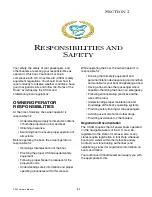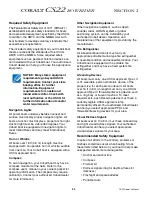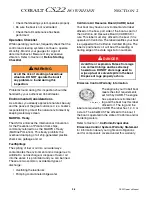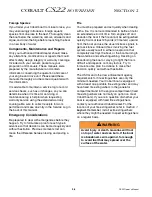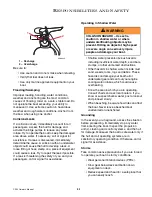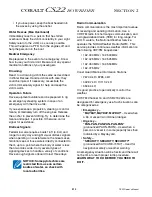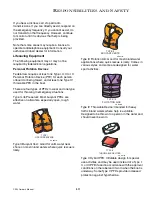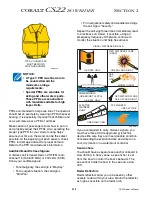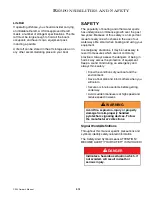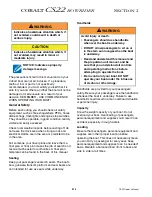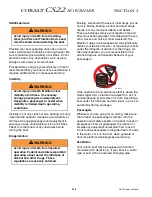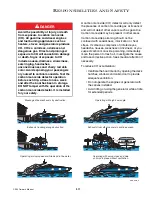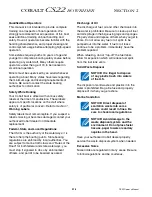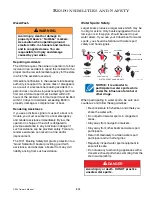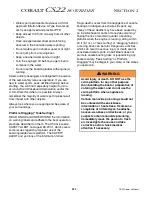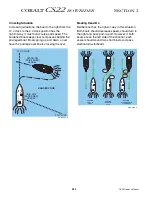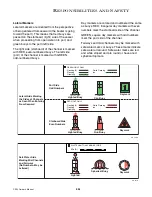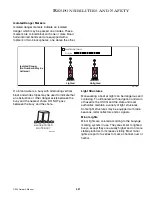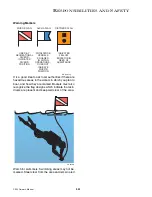
CS22 Owner’s Manual
2
-
15
R
ESPONSIBILITIES
AND
S
AFETY
Operating Conditions
Every waterway poses hazards that you should
avoid, such as shallow water, tree stumps and sand
bars. Ask local boaters for information and consult
a marine chart when boating on unfamiliar waters.
As the operator of the boat, you should try to avoid
all hazards, known and unknown. The following
information does not contain all possible water
hazards. Operating in shallow water presents a
number of hazards. Mud, sand, weeds and debris
can foul a propulsion unit propeller or its cooling
water. If a propulsion unit strikes an underwater
object, check the propulsion unit and boat for
damage. If a propulsion unit vibrates after striking
an object, it may indicate a damaged propeller.
Sand bars in narrow inlets are constantly shifting,
making it difficult to mark them with buoys. Tides in
coastal areas affect water levels, producing sand
bars. Sometimes sand bars are indicated by waves
as they form into breakers when passing over the
sand bar. Refer to
Grounding
, in this section, if you
run aground on a sand bar. The water level around
a dam spillway is a hazardous area. It is subject to
rapid changes caused by currents and turbulence.
Keep clear of the spillway areas below dams.
Weather/Seas
Getting caught in severe weather is hazardous. It is
recommended to check the weather, sea and wind
conditions not only before you boat, but also
periodically while you are boating. Refer to
Radio
Communications
, in this section, for weather
channel information. A change in wave height, wind
direction and speed indicates deteriorating
weather. Take common sense precautions if you
are forced to operate your boat in stormy
conditions:
• Wear PFDs.
• Stow gear below deck and batten down
equipment on deck.
• Reduce speed and head for a safe place that
you can easily reach.
If you lose power, keep the boat headed into the
waves by using the anchor.
Learn the storm signals.
It is best to avoid operating your boat in foggy
weather. When fog sets in, use your GPS and radar
unit, if equipped, to take bearings and log courses
and speeds. You are required to emit a five-second
blast from your horn or whistle once every minute.
Additionally, have passengers wear PFDs and
observe for oncoming vessels.
DAYTIME
WARNING
NIGHTTIME
WARNING
DESCRIPTION
COB_0032_A
Small Craft Advisory
- Winds
greater than 18 knots,
sustained for two hours or more
or hazardous wave conditions.
Following a storm, hazardous
wave conditions can persist
long after the high winds have
subsided.
Gale Warning
- Sustained
winds (2 or more hours),
of 34-47 knots.
Storm Warning
- Sustained
winds of 48 knots or greater.
Hurricane Warning
- Forecast
winds of 64 knots and above.
Displayed only in connection
with a hurricane.
Summary of Contents for CS22
Page 2: ...ii CS22 Owner s Manual COBAL T CS22 BOWRIDER ...
Page 8: ...viii CS22 Owner s Manual COBAL T CS22 BOWRIDER NOTES ...
Page 60: ...2 30 CS22 Owner s Manual COBAL T CS22 BOWRIDER SECTION 2 NOTES ...
Page 102: ...4 4 CS22 Owner s Manual COBAL T CS22 BOWRIDER SECTION 4 ...
Page 124: ...6 10 CS22 Owner s Manual COBAL T CS22 BOWRIDER SECTION 6 NOTES ...
Page 132: ...7 8 CS22 Owner s Manual COBAL T CS22 BOWRIDER SECTION 7 NOTES ...

